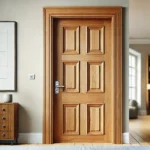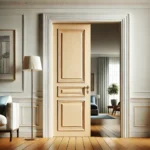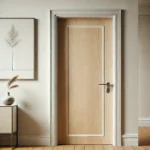French doors are an iconic and versatile element of architecture and interior design, known for their elegance and ability to transform spaces. Characterized by their glass panels and dual-opening design, French doors have become a popular choice in both residential and commercial settings. Their unique combination of functionality and style makes them a timeless addition to any home or building.
French doors are typically constructed with two vertical doors that open outward or inward, creating a wide and unobstructed passage. The defining feature of French doors is the use of multiple glass panes set within a frame, often separated by wooden or metal mullions. This design allows for natural light to flow freely between spaces, enhancing the sense of openness and brightness in a room. The glass panels also provide a visual connection between interiors and exteriors, making them a popular choice for patios, balconies, and garden entrances.
The origins of French doors date back to the 17th century during the Renaissance period in France. Influenced by the architectural emphasis on symmetry, proportion, and light, French doors were initially used to connect interior spaces to balconies or gardens. Over time, their design and functionality evolved, and they became a staple in homes and buildings worldwide. Today, French doors are celebrated for their ability to blend historical charm with modern practicality.
One of the most appealing aspects of French doors is their ability to create a seamless connection between indoor and outdoor spaces. When used as exterior doors, they provide a beautiful frame for outdoor views while allowing natural light to flood the interior. This feature is particularly desirable in homes with scenic surroundings, as French doors help to blur the boundaries between the indoors and nature. They are often used to enhance the flow between living rooms and patios, dining areas and gardens, or bedrooms and balconies.
French doors are equally effective in interior applications, where they serve as elegant room dividers. By using glass panels, they maintain a sense of openness and continuity while providing separation between spaces. For example, French doors can be used to divide a living room and dining area, creating distinct zones without sacrificing light or space. In offices or study rooms, they provide privacy while preserving a connection to the rest of the home.
The versatility of French doors extends to their design options, making them suitable for a wide range of architectural styles. Traditional French doors feature classic wooden frames and clear glass panes, exuding a timeless elegance that complements period-style homes and rustic interiors. Modern variations may incorporate sleek metal frames, minimalist designs, or frosted glass for a contemporary look. The adaptability of French doors ensures that they can seamlessly integrate into any aesthetic, from traditional to ultra-modern.
In terms of materials, French doors are commonly made from wood, metal, or uPVC. Wooden French doors are prized for their warmth and natural beauty, offering a timeless appeal that suits classic and rustic designs. Metal frames, often made of aluminum or steel, provide a more industrial and contemporary look while ensuring durability. uPVC is a popular choice for its affordability, low maintenance, and resistance to weathering, making it ideal for exterior applications.
French doors are available in a variety of configurations to suit different spaces and needs. Single French doors consist of one glass-paneled door, often used in smaller spaces or as a side entrance. Double French doors, which feature two doors that open outward or inward, are the most common configuration and are often used for larger openings. Sliding French doors combine the elegance of traditional French doors with the space-saving benefits of sliding mechanisms, making them ideal for areas with limited clearance.
Customization is another key feature of French doors, allowing homeowners to tailor them to their specific preferences. From the choice of glass type, such as clear, frosted, or decorative, to the color and finish of the frame, French doors can be designed to match any interior or exterior scheme. Hardware options, including handles, hinges, and locks, add another layer of personalization, ensuring that the doors are both functional and aesthetically pleasing.
In addition to their aesthetic value, French doors offer practical benefits. Their glass panels allow natural light to penetrate deeper into a space, reducing the need for artificial lighting and creating a brighter, more inviting atmosphere. This feature is especially beneficial in homes with limited windows or in areas that receive less sunlight. The enhanced natural lighting not only improves the ambiance but can also contribute to energy efficiency.
French doors are also an effective way to improve ventilation and airflow within a home. When opened, they create a wide passage that allows fresh air to circulate freely, helping to regulate indoor temperatures and improve comfort. This feature is particularly valuable in warmer climates or during the summer months when natural ventilation can reduce the reliance on air conditioning.
The installation of French doors requires careful planning to ensure they function properly and enhance the design of the space. Factors such as the size of the opening, the direction of the swing, and the type of frame and glass should be considered during the planning stage. Professional installation is often recommended to ensure the doors are aligned correctly and operate smoothly, especially for larger or custom configurations.
Maintenance is an important aspect of keeping French doors in good condition. Regular cleaning of the glass panels and frames helps maintain their appearance and functionality. Wooden frames may require periodic refinishing or sealing to protect against moisture and weathering, while metal frames can benefit from rust prevention treatments. Proper care ensures that French doors retain their beauty and durability for years to come.
French doors are not only functional and stylish but also add value to a property. Their timeless design and practical benefits make them a desirable feature for potential buyers, enhancing the overall appeal of a home. Whether used as a grand entrance, a connection to outdoor spaces, or an interior divider, French doors elevate the character and functionality of any space.
In conclusion, French doors are a versatile and timeless architectural feature that combines elegance with practicality. Their ability to create seamless connections between spaces, enhance natural light, and add aesthetic value makes them a popular choice in homes and buildings around the world. With a variety of materials, designs, and customization options available, French doors can be tailored to suit any style or need. Whether used indoors or outdoors, their charm and functionality ensure that they remain a cherished element of design for generations to come.
![]()





